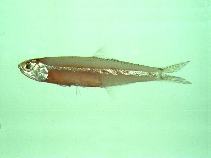| Family: |
Engraulidae (Anchovies), subfamily: Engraulinae |
| Max. size: |
8 cm SL (male/unsexed) |
| Environment: |
reef-associated; brackish; marine; depth range 0 - 50 m, oceanodromous |
| Distribution: |
Indo-Pacific: northern part of the Indian Ocean (Gulf of Aden, not Red Sea or the Persian Gulf, eastward to Burma) and western Pacific (Gulf of Thailand, Java Sea, also Hong Kong, Fujian and Taiwan Island; if correctly identified, then reaches to Fiji and Samoa) (Ref. 189). Mediterranean: Tel Aviv, Israel (Ref. 96660). |
| Diagnosis: |
Anal spines: 0-0; Anal soft rays: 17-20. Diagnosis: Body somewhat compressed, belly with 4-8 small needle-like pre-pelvic scutes; a small pre-dorsal spine in some specimens; maxilla tip pointed, reaching to or beyond hind border of pre-operculum, the latter concave, indented near maxilla tip; lower gillrakers 21 to 28; fine teeth on upper edge of hyoid bones; anal fin short, usually with 3 unbranched and 14-17 branched finrays, its origin below about middle of dorsal fin base; a double pigment line on back behind dorsal fin; tail deep yellow, at least in Indian specimens (Ref. 189). Of species with an indented pre-operculum, Stolephorus andhraensis has fewer gillrakers, 20-21, and S. ronquilloi has more gillrakers, 28-30; other species with a pre-dorsal spine also have a spine on the pelvic scute, like in S. dubiosus, S. baganensis and S. tri; hyoid tooth patches are present in S. commersonnii, but pre-operculum rounded, scutes usually 1-4, and in S. carpenteriae, but no pigment lines on back, anal origin under anterior part of dorsal fin base (Ref. 189).
Description: Body somewhat compressed (Ref. 189). Maxilla tip pointed, reaching to or beyond hind border of pre-operculum (Ref. 30573). Number of gillrakers on upper limb 16-20, gillrakers on lower limb 21-28 (Ref. 189, 122132). Anal-fin origin below dorsal-fin base (Ref. 30573). With 4-8 small needle-like pre-pelvic scutes, no post-pelvic scutes (Ref. 189, 30573).
Colouration: A double pigment line on back behind dorsal fin; tail deep yellow, at least in Indian specimens (Ref. 189, 30573). |
| Biology: |
Coastal pelagic (Ref. 68964). A schooling species occurring in coastal waters. More data needed based on correct identifications. The record from the Godavari estuary implies tolerance of lowered salinities, but the identity of the material is uncertain (perhaps S. waitei). Appears to be fairly common throughout its range. Used as bait in the tuna fishery in the South Pacific, although rather fragile. |
| IUCN Red List Status: |
Data deficient (DD); Date assessed: 10 March 2020 Ref. (130435)
|
| Threat to humans: |
harmless |
Source and more info: www.fishbase.org. For personal, classroom, and other internal use only. Not for publication.

